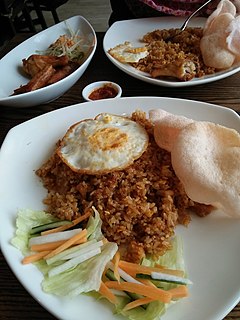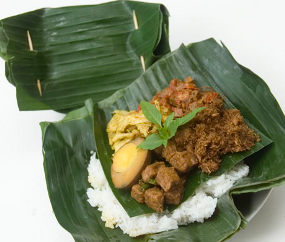
Indonesian cuisine is a collection of various regional culinary traditions that formed the archipelagic nation of Indonesia. There are a wide variety of recipes and cuisines in part because Indonesia is composed of approximately 6,000 populated islands of the total 17,508 in the world's largest archipelago, with more than 1,300 ethnic groups. Many regional cuisines exist, often based upon indigenous culture with some foreign influences. Indonesia has around 5,350 traditional recipes, with 30 of them considered the most important. Indonesia's cuisine may include rice, noodle and soup dishes in modest local eateries to street-side snacks and top-dollar plates.

Rijsttafel, a Dutch word that literally translates to "rice table", is an Indonesian elaborate meal adapted by the Dutch following the hidang presentation of nasi padang from the Padang region of West Sumatra. It consists of many side dishes served in small portions, accompanied by rice prepared in several different ways. Popular side dishes include egg rolls, sambals, satay, fish, fruit, vegetables, pickles, and nuts. In most areas where it is served, such as the Netherlands, and other areas of strong Dutch influence, it is known under its Dutch name.

Nasi uduk is an Indonesian style steamed rice cooked in coconut milk dish, which originated from Java. It was the brainchild of Sultan Agung of Mataram, inspired by his experience eating kebuli rice.

Nasi goreng is a Southeast Asian fried rice dish, usually cooked with pieces of meat and vegetables. One of Indonesia's national dishes, it is also endemic in Malay-speaking communities in countries such as Malaysia, Singapore and Brunei, and has gained popularity in Sri Lanka through migrations from the Malay Archipelago, in countries like Suriname via Indonesian immigrant communities, and in the Netherlands through its colonial ties with Indonesia. Nasi goreng is distinguished from other Asian fried rice preparations by its distinct smoky aroma, and caramelised yet savoury undertones of flavour. There is no single defined recipe for nasi goreng, and its composition and preparation varies greatly from household to household.

A banana fritter is a fritter made by deep frying battered banana or plantain in hot oil. It is a common dish across Southeast Asia and the Indian subcontinent.

Javanese cuisine is the cuisine of Javanese people, a major ethnic group in Indonesia, more precisely the province of Central Java, Yogyakarta and East Java.

Tumpeng is an Indonesian cone-shaped rice dish with side dishes of vegetables and meat originating from Javanese cuisine of Indonesia. Traditionally featured in the slamatan ceremony, the rice is made by using a cone-shaped woven bamboo container. The rice itself may be plain steamed rice, uduk rice, or yellow rice.

Nasi kuning, or sometimes called nasi kunyit, is an Indonesian fragrant rice dish cooked with coconut milk and turmeric, hence the name nasi kuning.

Nasi bogana or nasi begana, pronounced as nah-see boh-gâna, is an Indonesian style rice dish, originally from Tegal, Central Java. It is usually wrapped in banana leaves and served with side dishes.

Sundanese cuisine is the cuisine of the Sundanese people of Western Java, and Banten, Indonesia. It is one of the most popular foods in Indonesia. Sundanese food is characterised by its freshness; the famous lalab eaten with sambal and also karedok demonstrate the Sundanese fondness for fresh raw vegetables. Unlike the rich and spicy taste, infused with coconut milk and curry of Minangkabau cuisine, the Sundanese cuisine displays the simple and clear taste; ranged from savoury salty, fresh sourness, mild sweetness, to hot and spicy.

Nasi ulam is an traditional Indonesian dish of steamed rice (nasi) served with various herbs and vegetables (ulam)

Nasi kucing is an Indonesian rice dish that originated from Central Java, primarily Yogyakarta, Semarang, and Surakarta but has since spread. It consists of a small portion of rice with toppings, usually sambal, dried fish, and tempeh, wrapped in banana leaves.

Nasi bakar refer to steamed rice seasoned with spices and ingredients and wrapped in banana leaf secured with lidi semat and later grilled upon charcoal fire. The burned banana leaf produced a unique aroma upon the rice. The banana leaf package is opened upon consumption. It is a relatively newly developed Indonesian dish around the early 2000s, probably derived from nasi timbel rice wrapped in banana leaf. (Source?)

Nasi timbel is an Indonesian hot dish, consisting of steamed rice wrapped inside a banana leaf. It is a traditional Sundanese cuisine from West Java. The heat of the hot-cooked rice touches the banana leaf and produces a unique aroma. It is made in ways similar to making lontong; compressed, rolled, and wrapped in banana leaves; it then evolves into a complete dish served with various side dishes such as fried chicken, empal gepuk, jambal roti, tahu goreng, tempeh, salted duck egg, sayur asem, with lalab and sambal. Nasi timbel later evolved to nasi bakar.

Lontong cap go meh is a Chinese Indonesian take on traditional Indonesian dishes, more precisely Javanese cuisine. It is lontong rice cake served with richly-flavoured dishes which include opor ayam chicken in coconut milk, sayur lodeh vegetable soup, hot and spicy liver, hard-boiled pindang egg, koya powder made of soy and dried shrimp or beef floss, pickles, chili paste and prawn cracker. Lontong cap go meh is usually consumed by Chinese Indonesian community during the Cap go meh celebration.

Balinese cuisine is a cuisine tradition of Balinese people from the volcanic island of Bali. Using a variety of spices, blended with the fresh vegetables, meat and fish. Part of Indonesian cuisine, it demonstrates indigenous traditions, as well as influences from other Indonesian regional cuisine, Chinese and Indian. The island's inhabitants are predominantly Hindu and culinary traditions are somewhat distinct with the rest of Indonesia, with festivals and religious celebrations including many special foods prepared as the offerings for the deities, as well as other dishes consumed communally during the celebrations.

Sambal is a chilli sauce or paste, typically made from a mixture of a variety of chilli peppers with secondary ingredients such as shrimp paste, garlic, ginger, shallot, scallion, palm sugar, and lime juice. Sambal is an Indonesian loan-word of Javanese and Sundanese origin. It originated from the culinary traditions of Indonesia, and is also an integral part of the cuisines of Malaysia, Sri Lanka, Brunei and Singapore. It has also spread through overseas Indonesian populations to the Netherlands and Suriname.

Nasi campur, also known as nasi rames or ꦱꦼꦒꦕꦩ꧀ꦥꦸꦂ [sə'gɔ ˈtʃampur] in Java, refers to an Indonesian dish of a scoop of nasi putih accompanied by small portions of a number of other dishes, which includes meats, vegetables, peanuts, eggs, and fried-shrimp krupuk. Depending on origin, a nasi campur vendor might serve several side dishes, including vegetables, fish, and meats. It is a staple meal from Indonesia and popular in Malaysia, Singapore, Brunei, and southern Thailand, and also the Netherlands through its colonial ties with Indonesia. A similar form called chanpurū exists in Okinawa.

Nasi tutug oncom or sometimes simply called tutug oncom, is an Indonesian style rice dish, made of rice mixed with oncom fermented beans, originally from Tasikmalaya, West Java. It is usually wrapped in banana leaves and served with various side dishes.

Bawang goreng is an Indonesian crispy fried shallots condiment, a popular garnish to be sprinkled upon various dishes of Indonesian cuisine. It is quite similar to crisp fried onion.



















